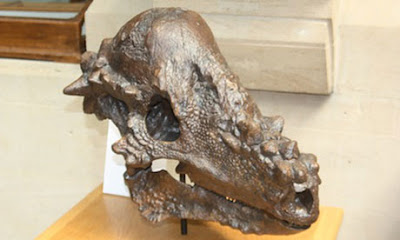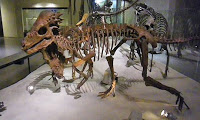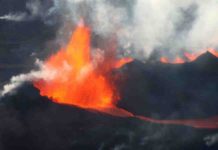
Working out the functions of various features of long extinct animals can be fraught with difficulty. For every case where it is really rather obvious (pterosaurs could fly with their wings, and the teeth of tyrannosaurs were not used for opening coconuts) there are those that are contentious, or just plain baffling. One of the more controversial has been the huge domes on the heads of many pachycephalosaurian dinosaurs.
That mouthful of a name roughly translates as “thick-headed reptiles” and this time at least it’s a fair comment. The largest forms had the best part of 10 inches (25 cm) of solid bone on the top of their skull, giving them a unique appearance and indeed unique structure. In some this was elaborated with a frill of spikes at the back of the head and various knobs and bumps across the main dome. On animals that are otherwise quite lightly built and apparently fast and agile bipeds, it is quite a feature.
This certainly looks like some form of battering ram. The idea that these animals faced off and charged in, head lowered, to butt at one another’s heads or flanks gained in popularity and there are plenty of dramatic images of pachycephalosaurs charging into one another in the manner of buffalo or bighorn sheep, and the idea of the Cretaceous echoing to the cracks of impacting dinosaur skulls is certainly an evocative one.

However, more recently a number of analyses and suggestions have made the area much more contentions. Various studies have concluded that the heads of these animals either would, or would not, shield the brain from serious injury in case of impacts and it has even been suggested that the heads were purely for display. To complicate matters a little further, a number of specimens don’t seem to have the thick domes, but more of a flat head (though sometimes with various knobs and spikes still being present) and it is not clear if these were different species, or juveniles or females of known species. Into this debate steps a new paper with a totally new line of evidence.
Pachycephalosaur remains are actually rather rare, but the one thing that does survive well are the domes themselves since they are very tough chunks of solid bone. Researchers examined over 100 preserved skulls and isolated domes (also called skull-caps) and found a pretty consistent pattern – they very often suffered from damage and modifications to the cap consistent with injuries. Now injuries in wild animals are quite common. Over a lifetime, most animals will suffer the odd accident or disease that will leave its mark on the skeleton and can be seen. However, the damage observed is collectively far more than just odd incidences of trauma.
For a start, they are pretty much all on the top of the dome – where a head-down strike would most likely impact – and not randomly distributed across the skulls, which would be expected from general accidents. Second, the number of incidences is high (22% of animals, a little lower than in sheep and higher than in bison), and much more than would be expected from normal accidents or chance, implying some kind of behaviour that repeatedly leads to cranial injuries. Furthermore, injuries of this kind appear to be absent in the specimens of pachycephalosaurs that don’t have thick skull-caps, meaning that rates of damage are obviously still more common in the domed animals, and also that damage seems to correlate with having the dome.

In short, there is good reason to think that these animals really were impacting with their heads: the giant dome of bone was both weapon and crash helmet. It isn’t clear if this was true head-to-head impacts, or more generalised butting of whatever bits of their opponents they could hit, but they were clearly hitting things, and hard. That they were doesn’t rule out that the domes might also have been used to signal dominance, but clearly they had a major role in combat and individuals were clearly facing off and fighting.
It seem we can use these impressive animals’, in some cases, rather nasty skull trauma injuries to show what they got up to around a hundred million years ago. With the largest individuals weighing close to half a tonne, the clashes would presumably have been spectacular.
Note : The above story is reprinted from materials provided byhttp://guardian.co.uk. The original article was written by Dr Dave Hone.










